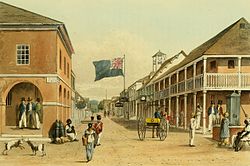19th century

- 1802 – Kingston incorporated. [11]
- 1807 – Slave trade officially abolished per Slave Trade Act.
- 1823 – Population: 33,000 (approximate). [12]
- 1824 – Jamaica Journal and Kingston Chronicle newspaper begins publication. [13]
- 1825 – Jamaica Horticultural Society founded. [10]
- 1834
- Slavery officially abolished per Slavery Abolition Act.
- Jamaica Gleaner newspaper begins publication. [14] [15]
- Mico College founded. [2]
- 1843
- 1845 – Spanish Town-Kingston railway (Jamaica Railway Company) begins operating [17] and Kingston railway station opens.
- 1862 - Fire. [3]
- 1870 – Legislative Council of British Jamaica moves to Headquarters House. [2]
- 1872
- Capital of British Jamaica relocated to Kingston from Spanish Town. [17] [3]
- Victoria Market built on site of "Sunday/Negro market." [18]
- Jamaica Club founded. [2]
- 1879 – Institute of Jamaica [19] and Sugar Wharf established. [20]
- 1881
- 1882 – 11 December: Fire. [23]
- 1885 – Shaare Shalom Synagogue built.
- 1887 – Jubilee Market dedicated. [24]
- 1890 – Chinese Benevolent Society founded. [17]
- 1891
- Constant Spring Hotel in business (approximate date). [25]
- Population: 46,542. [21]
- Jamaica International Exhibition held. [10]
- 1892 - Electricity came to Jamaica. [26]
- 1894 – Montego Bay-Kingston railway begins operating. [17]
- 1897 – Victoria Park opens (approximate date).[ citation needed ]
- 1898 – Adrian Robinson becomes mayor. [27]
- 1899 – Electric tram begins operating.